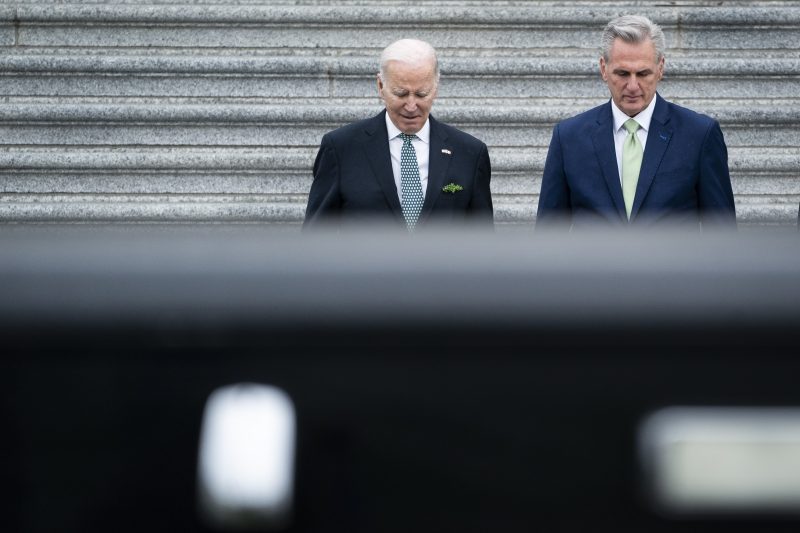The clock is ticking on what is likely to be Congress’s most consequential debate of 2023. House Speaker Kevin McCarthy (R-Calif.) and President Biden are increasingly dug in over McCarthy’s demand to cut spending in exchange for Congress raising the debt ceiling, with a deadline looming this summer.
And a new poll reinforces how delicate and potentially unworkable that balancing act ahead is.
The AP-NORC poll shows that Americans, by and large, like the idea of spending cuts. Fully 60 percent say the government is spending too much, while just 16 percent say it’s spending too little. An additional 22 percent say it’s spending about the right amount.
It’s one of the biggest splits since the tea party era in favor of the idea that the government spends too much. In 2020 and 2018, for example, the same poll showed more Americans thought we were spending too little than too much. And such polls are already being cited as a mandate for the House GOP’s debt-ceiling strategy.
But the poll also shows how quickly that falls apart when you start getting even a little into the specifics.
The poll expanded on its overall question by isolating 16 areas where spending could theoretically be cut. In only one area specifically did a majority say that the government was spending too much in that area specifically: assistance to other countries, at 69 percent. (Many Republicans think we’re spending too much to help Ukraine, which could help explain that.)
But this kind of foreign aid is usually less than 1 percent of the budget, meaning any savings there would be meager. And Americans overwhelmingly oppose cutting spending in the areas in which doing so could actually make a dent in the federal budget deficit.
About 6 in 10 say the government is spending “too little” on Social Security, Medicare, health care more broadly, education and infrastructure. On none of these areas do even 1 in 5 Americans agree that we’re spending too much.
These things actually combine for a majority of the federal budget. Health care accounts for about one-quarter of the budget. Social Security, on which only 7 percent say we’re spending too much, accounts for about one-fifth of the budget.
Those numbers explain why McCarthy has effectively said that Medicare and Social Security are off the table in debt-ceiling negotiations. But finding significant cuts elsewhere is extremely difficult.
The other really big chunk of the budget? Defense spending, which is about one-eighth of it. The poll shows more openness to cutting there, but still, only 29 percent of Americans say we’re spending too much, while more — 35 percent — say we’re spending too little. (Again, Ukraine could be the reason here, though the Pentagon has sought to separate Ukraine funding from its overall budget request.)
Republicans have occasionally spotlighted defense as an area where spending could be cut, but even there the difficulties are apparent. Some Republicans have argued for increasing defense spending beyond the levels requested by the Biden administration, and McCarthy has taken care to argue that what Republicans are talking about is freezing defense spending than cutting it.
The numbers echo data from other pollsters. The Pew Research Center in 2019, for instance, asked about whether Americans wanted more or less spending in 13 areas. In only one did more than one-quarter want spending reduced: again, foreign aid (specifically, assistance to the needy in the world). Only about one-quarter wanted to cut military defense spending.
And in every case, more Americans wanted to increase spending rather than cut it. Fewer than 1 in 10 wanted cuts in any of the other areas mentioned above from the AP-NORC poll.
The problem for McCarthy and the GOP is that once you exclude these big-ticket items, it becomes virtually impossible to balance the budget or even come close to substantial cuts. A recent study from the Committee for a Responsible Federal Budget showed that if you take defense, veterans, Social Security and Medicare spending cuts off the table, you would need to cut 85 percent of the remaining budget to balance it within 10 years, as House Republicans have said they aim to do.
For these reasons, McCarthy and Republicans have been reluctant to publicly propose specific cuts, and Biden is pressing them to do so, in the form of an actual budget. McCarthy has responded that it’s unnecessary to propose one since the budget is handled separately from the debt ceiling.
This poll shows why McCarthy would prefer this debate remain in the abstract, but at some point it will have to involve actual proposed cuts.
And assuming the proposed cuts are actually substantial, they are very likely to give even the many Americans who think the government spends too much something to hate.

